Storage Infortrend is an alternative to A-brands. Review and Testing
 Data storage systems are increasingly used in the IT infrastructure of the small and medium business segment. Workplaces migrate to the virtual environment, and for storing data the usual “file bin” in the form of old iron stuffed with disks is no longer enough. Therefore, for many small companies, sooner or later the question arises of choosing an entry-level Enterprise storage system. The tasks before the storage system become typical: to ensure the necessary performance, fault tolerance and compatibility with the existing IT infrastructure. But, unfortunately, the decisive factor of choice is the validity of the cost of the decision.
Data storage systems are increasingly used in the IT infrastructure of the small and medium business segment. Workplaces migrate to the virtual environment, and for storing data the usual “file bin” in the form of old iron stuffed with disks is no longer enough. Therefore, for many small companies, sooner or later the question arises of choosing an entry-level Enterprise storage system. The tasks before the storage system become typical: to ensure the necessary performance, fault tolerance and compatibility with the existing IT infrastructure. But, unfortunately, the decisive factor of choice is the validity of the cost of the decision.First-tier manufacturers have suitable products that meet all the requirements for functionality and level of service. But with the compatibility and cost of ownership of such solutions there are certain difficulties. Therefore, this article is devoted to the alternative to A-brands - the data storage system Infortrend.
Infortrend is a representative of Taiwan manufacturers with a narrow specialization in data storage systems. For more than 20 years of work on the design and production of its own storage systems, Infortrend has created a product that successfully competes with representatives of major world brands.
Infortrend main product line
EonStor GS is a unified SAN and NAS storage with file, block and object access within a single device.
')
EonStor GSe - 1-controller budget option EonStor GS
EonServ - hybrid solutions, classic x86 server + software RAID Infortrend.
EonStor DS is the most common lineup of storage systems. It is a classic block-access SAN, the functionality and performance of which will be discussed later in this article on the example of the Infortrend ESDS 3012T model.
Stand Specification
Infortrend ESDS 3012T storage system consisting of:
Form factor: 2U Rackmount (depth - 529 mm)
Set for installation in 19 "a rack. Distance between frames from 24" to 36 "
Dual RAID controller (High IOPS)
RAID level 0, 1 (0 + 1), 3, 5, 6, 10, 30, 50, 60
4GB DDR-III Dual Controller (optional up to 32GB DDR-III Dual Controller)
2 x FBWC Module
Host ports are standard: (4 + 4) x 1GbE - RJ-45 (iSCSI)
Host ports optional: (2 + 2) x 10GbE - RJ-45 iSCSI
(4 + 4) x 1GbE - RJ-45
(2 + 2) x 10GbE - SFP + (iSCSI)
(4 + 4) x 8/4 / 2Gb FC
(2 + 2) x 16Gb FC
(4 + 4) x 8Gb FC / (2 + 2) x 16Gb FC / (4 + 4) x 10Gb iSCSI (converged)
(2 + 2) x 6Gb x4 SAS
(2 + 2) x 12Gb SAS
Expansion ports: (1 + 1) x SAS 6G x4
Up to 312 HDD in one system (with additional JBOD Infortrend connected)
12 disk bays of HotSwap SerialATA / SAS
4 x SSD 200GB SATA 6G eMLC NAND Enterprise (84K / 12K R / W IOps, 550/230 MB / s R / W, 1.1PB write resource)
8 x HDD 6000GB SAS 12G 7200rpm
Failsafe power supply with hot-swappable 1 + 1 530W
Cachesafe
Multi-pathing
Thin provisioning
Automated Storage Tiering (optional 2 tiers / 4 tiers)
Local replication
Advanced Local Replication: Snapshot and Volume Copy / Mirror (optional)
Remote Replication (optional)
Management: SANWatch management suite, Terminal via RS-232C, Telnet / SSH, LCD keypad panel
Notifications: Email, Fax, LAN broadcast, SNMP traps, SMS, Skype
SSD Cache
Infortrend warranty 36 months. Repair and maintenance in the service center STSS.
Photo report

Despite the compact dimensions of the storage system itself, it comes in a fairly overall box.

The dimensions of the packaging are due to the fact that the baskets with discs are stacked in separate compartments of the box. This ensures the safety of such fragile items during transport. In the storage systems of other manufacturers, disks usually go already installed inside the case.

Storage controllers in this series support the installation of a single host interface card.
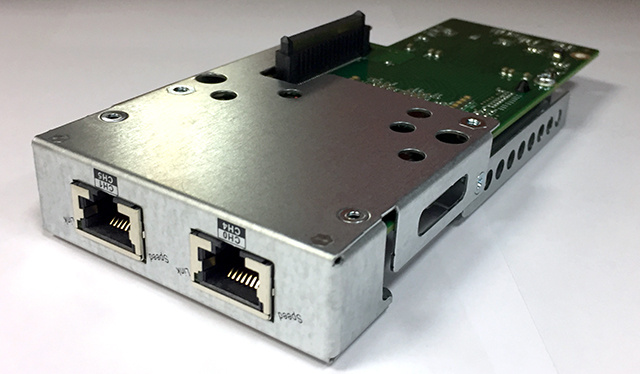
Optionally, host cards with various connection interfaces are supported.

Universal Disc Baskets - allow you to install both 2.5 "and 3.5" disks without using additional adapters.
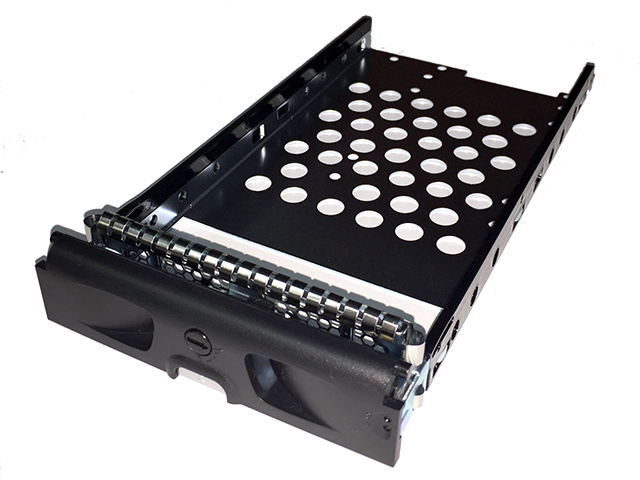
A unique feature of Infortrend storage systems is the use of SATA drives in 2-controller configurations. This is implemented with the help of a specialized card that allows you to simulate 2 ports on one SATA interface, which provides connection to two controllers for fault tolerance.

For example, to build a budget solution with a high level of IOPS, in this storage system you can use classic Enterprise SSD with SATA interface.
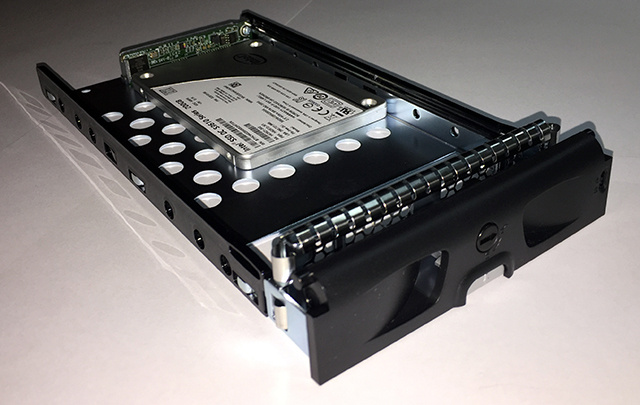
Testing
To test the performance, 5 configurations of the disk array and 4 load modes were selected.
Configurations:
1. RAID10 : 4 x Intel SSD 200Gb S3610
2. RAID5 : 8 x Seagate HDD SAS 6000Gb, Enterprise Capacity 3.5, SAS 12Gb / s, 7200 rpm, 128Mb buffer
3. RAID5 + SSD Cache : 8 x Seagate HDD SAS 6000Gb, Enterprise Capacity 3.5, SAS 12Gb / s, 7200 rpm, 128Mb buffer + 1 x Intel SSD 200Gb S3610
4. RAID6 : 8 x Seagate HDD SAS 6000Gb, Enterprise Capacity 3.5, SAS 12Gb / s, 7200 rpm, 128Mb buffer
5. RAID6 + SSD Cache : 8 x Seagate HDD SAS 6000Gb, Enterprise Capacity 3.5, SAS 12Gb / s, 7200 rpm, 128Mb buffer + 1 x Intel SSD 200Gb S3610
Load Scenarios:
1. Database
Access 100% / Read 67% / Random 100%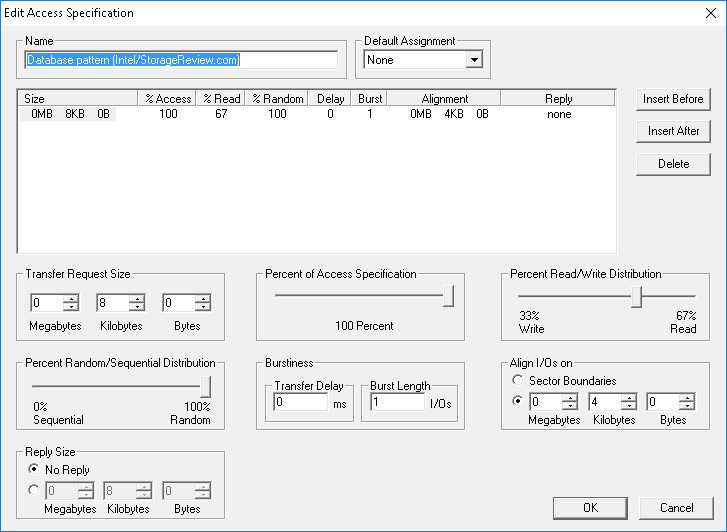

2. File Storage
Access 2-60% / Read 80% / Random 100%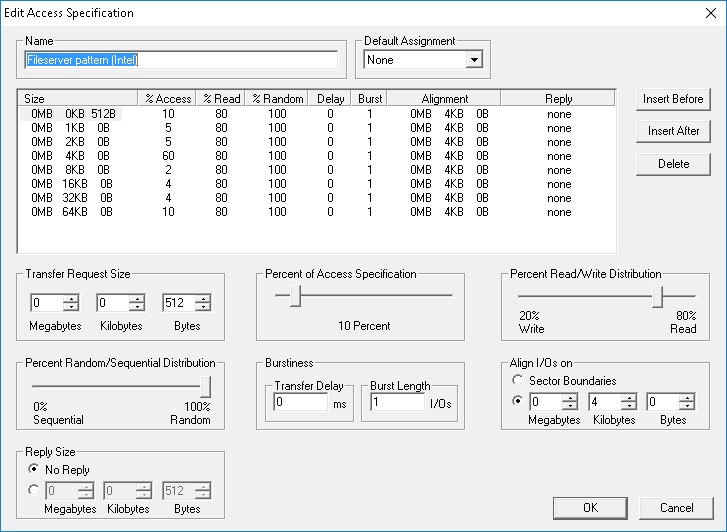

3. VDI
Access 100% / Read 20% / Random 80%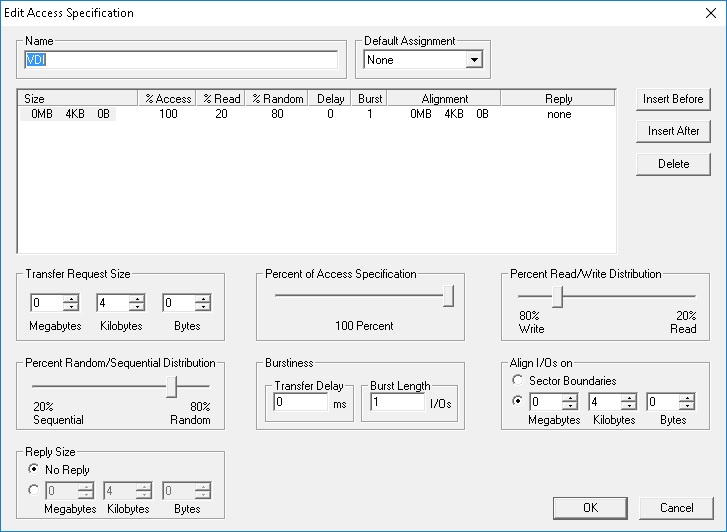

4. WEB-service
Access 1-23% / Read 100% / Random 100%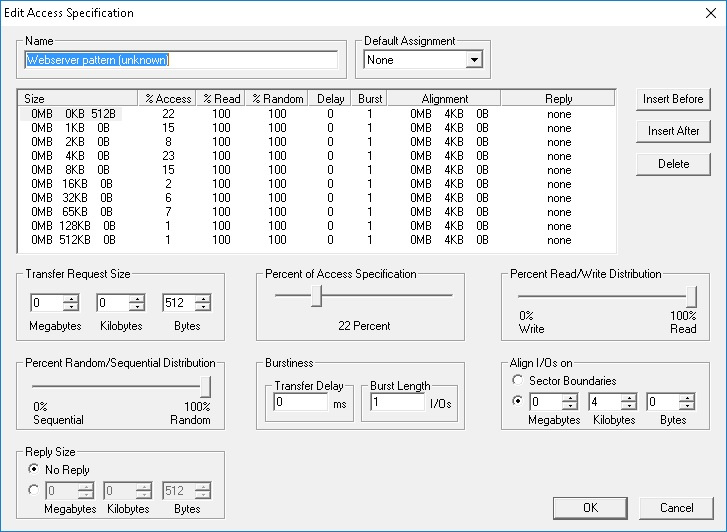

Summary table of results:

Next, consider the comparative graphs.
The results of SSD and HDD are not meaningful and unreadable in one chart - the difference between HDD modes is lost, but I will leave one graph.
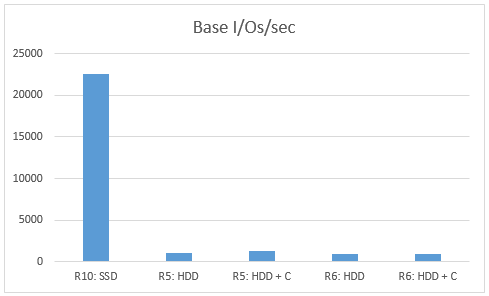
And that's why. There are customers who, for a database of relatively small size, but with a large number of users, choose arrays on the HDD and ignore the use of SSDs. The reasons are the "low" life of solid-state disks and the "high" reliability of SAS HDD. And in order to “improve” the performance, the disks do not take 7.2K, but SAS 15K. In the current realities, according to statistics, the probability of failure of a spindle disk threshing at a speed of 15,000 revolutions per minute is much higher than that of a server SSD with a gigantic rewriting resource and having no moving elements.
And this graph, in addition, reflects the gap in performance between the SSD array and HDD, and it does not matter which drives are used - SSDs will produce a result at least an order of magnitude better (using SAS SSD, the performance will be even higher).
Since we are testing all the storage systems and not disks, let's take a closer look at the performance of arrays in various modes.


There is a regular decline in the performance of RAID6 compared to RAID5 - this is an inevitable victim in favor of fault tolerance. SSD Cache in most cases, even in synthetic tests, showed a performance boost. I believe that in real conditions this difference will be even greater.
Advantages of Storage Infortrend
I will not suck from the finger, but I will write frankly - the advantages of only 2:
1. Storage Infortrend supports most models of classic Enterprise drives available on the market. This means, firstly, there is no need to overpay, at the time of purchase of storage systems, for branded (the same) disks, as in the case of A-brands, and secondly, there are no problems with replacing non-warranty disks in the future, in 3-5 etc. years of operation. There is always a suitable replacement on the market, and you don’t have to buy branded disks through the service channel at times more expensive than modern counterparts.
2. As I already mentioned - Infortrend works without problems (with a certain loss of performance) and works with SATA Enterprise disks like SDD and HDD. But, using SATA HDD is not profitable, because SATA disk cost + MUX card = NL SAS cost, same volume. But with the SSD, the situation is different - not only is SAS SSD so far rare, and they cost significantly more than SATA analogs. In addition, the SAS SSD overwriting resource does not capture the segment of corporate drives of primary and secondary levels. Using SATA SSD (for example, Intel S3520 or S3610), you can build a budget storage system with high performance. When I say budget - it means 3-4 times cheaper than A-brands.
There is another feature of the Infortrend storage system. It can be attributed to both disadvantages and advantages - it all depends on where you bought it. This is a guarantee, or rather, the absence of an official guarantee on the territory of the Russian Federation. But we give our guarantee for Infortrend from 2 to 3 years (depending on the model), with service in the SC throughout Russia. To ensure prompt replacement, we have a guarantee warehouse.
To calculate the model and select the required specifications, we have a convenient configurator on our site. It also presents the model ESDS 4024B , which supports the installation of 2 interface boards for each controller.
findings
Recently, Infortrend storage systems have become a popular solution in the field of small and medium businesses due to the advantages described above. The possibility of use in poly-brand solutions allows you to integrate storage systems into existing infrastructure without reference to the manufacturer of server and network equipment. One of the most frequent use cases for data storage systems is to build a fault-tolerant cluster. Also, no small part of the projects is the replacement of brand storage on Infortrend. This happens when the customer is faced with a choice - replacing non-warranty branded disks or a new storage system with disks for the same money.
Thank you for your attention, waiting for your comments.
Source: https://habr.com/ru/post/334226/
All Articles